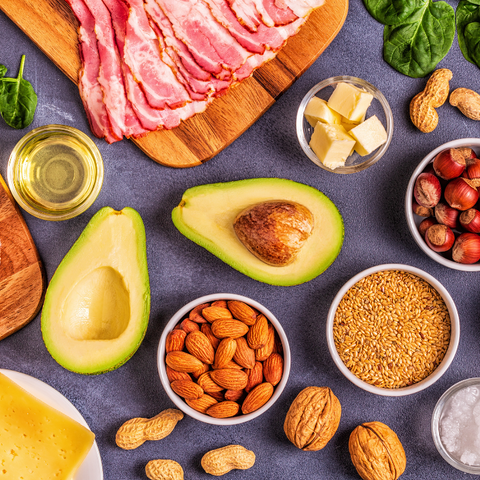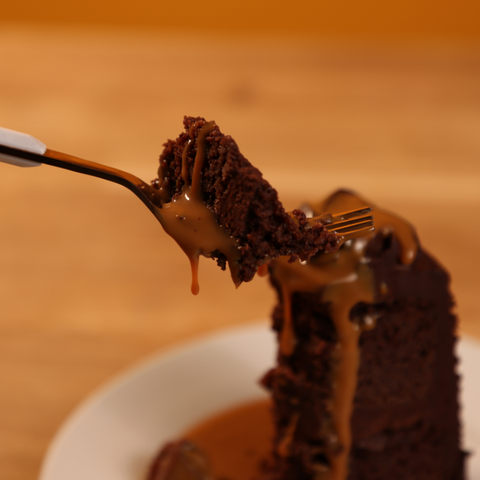In recent years, an increasing number of people have been turning to low-carb diets to improve their health and lose weight. There are two popular variations of a low-carb diet. They are the ketogenic diet (keto) and the traditional low-carb diet. Both diets limit carb intake but there are a few things–macronutrient ratios, food choices, and their effects on the body that create significant differences. In this article, we'll explore the difference between a keto and a low-carb diet and help you determine which one might be the best fit for your health goals. Let's dive in.
What Is the Keto Diet?
The keto diet is a diet that involves consuming low amounts of carbohydrates and high amounts of fats with the aim is of inducing a metabolic state known as ketosis.
Ketosis: it's a natural metabolic process where your body burns fats for energy instead of carbohydrates. When you restrict your carb intake to 20-50 grams per day and increase your fat intake, your liver begins producing ketone bodies which act as an alternative fuel source. As your body adjusts to this new fuel source, it starts burning stored body fat instead of the carbs you eat.
Ketosis is the reason why the keto diet is so efficient and it's also the reason why the keto diet has proven to be beneficial for individuals with various medical conditions, including epilepsy, seizures, diabetes, metabolic syndrome, and obesity
What's a low-carb diet?
A low-carb diet is a way of eating that restricts carbohydrates, mainly from grains, sugar-sweetened beverages, and bread. It typically involves reducing or eliminating processed foods, sugary snacks and drinks, and replacing them with high-fibre vegetables, healthy proteins, nuts, seeds and other low-carbohydrate foods. It's typically a less restrictive diet compared to a keto diet.
Low Carb vs. Keto: Differences & Similarities?
Some of the main differences between the two diets are that in a keto diet, carb intake is restricted to below 20g or less of carbs per day. With an allowable carb count that low, it’s been shown to be especially effective for those looking to lose weight quickly as it can put your body in a state of ketosis where it burns fat instead of carbs for fuel. A low-carb diet, on the other hand, isn’t as strict. With a low-carb diet, people usually don’t have a set rule about how many carbs to consume but they usually eat about 50g - 150g of carbs per day. A low-carb diet definitely won’t put you in ketosis as the keto diet does, but it still offers some benefits. Another major difference is the amount of protein you eat on each diet. On a low-carb diet, you'll typically consume more protein than on a keto diet since keto requires moderate protein consumption (20-22% of total calories). Additionally, fats account for a much greater portion of your daily calories on a keto diet compared with a low-carb one.
Macronutrient Ratios
A keto diet typically involves consuming 70 - 75% of calories from fat, 20 - 25 % from protein and between 5 - 10% from carbs. These percentages can vary depending on individual needs and goals so it's a good idea to consult with a healthcare professional or registered dietician before starting. Additionally, both diets emphasise the importance of choosing healthy sources of fats and proteins such as avocados, nuts, seeds, fatty fish, lean meats and other vegetables such as celery, tomatoes, spinach and mushrooms.

Low Carb & Keto pros and cons
While there are some great benefits to following a low-carb diet, it’s important to understand the pros and cons before committing to one.
The main pro of a low-carb diet is that it can lead to rapid weight loss in a short amount of time. By reducing your carbohydrate intake, your body will begin burning fat instead of carbs for fuel which is an effective way to lose weight quickly. Additionally, eliminating processed high-carb foods from your diet may help you improve blood sugar control and reduce certain risk factors for heart disease as well as type 2 diabetes.
On the flip side, following a low-carb diet can be quite restrictive as you won’t be able to enjoy as many foods as you normally would on a regular diet. It can also be difficult to sustain long-term due to its strict nature; if you cheat even once or twice, you may find yourself gaining back all the progress you made. Lastly, depending on how extreme your carb restriction is, there could be an adaptation phase when starting out where you feel fatigued or weak until your body adjusts.
Food Choices
When following a low-carb and keto diets, it may appear that one's food options are limited. To address this, one can substitute high-carb foods for low-carb alternatives and explore other options for familiar meals such as pancakes, bread, or rice.
In our article about Swapping High Carb Foods for Low Carb Foods, we go into much more detail about how to do this.
Which option offers better overall health benefits?
When it comes to overall health, deciding between a keto diet or a low-carb diet can be difficult. While both plans can be effective for weight loss and improved health, there are some key differences between them that should be considered before making a decision.
Transitioning into either plan may present its own unique challenges; those going low carb may experience weakness and constipation due to their micronutrient intake, while those starting out on a keto diet might encounter the “keto flu” which includes symptoms such as headaches and fatigue. A study in the Journal of Sports Sciences also found that people going low carb may experience weakness and constipation due to their micronutrient intake. Meanwhile, those starting out on a keto diet might encounter the “keto flu” which includes symptoms such as headaches and fatigue.
A study in the Journal of the American College of Cardiology revealed that going low carb was associated with higher states of remission among people with type 2 diabetes, while keto diets could improve heart health according to another study in the BMJ.
Ultimately, when it comes to overall health it's best to speak with your healthcare provider about what works best for you and your lifestyle. With the right guidance and support, you can find success on whichever plan you choose!
Tips for Success
When starting a keto or low-carb diet, following specific guidelines is recommended to attain long-lasting success.
- Get rid of anything non-keto: We know how easy it is to be tempted into taking an extra sugary snack or a soda once you've decided to go on a keto diet. This may be one of the biggest temptations. It's important to get rid of everything you used to eat on a keto diet—stuff like bread, pasta, sugary cakes and juices.
- Research: Hopefully, since you're reading this, you have an understanding of what a keto diet is and how it differs from a low-carb diet. But that's not the end. It's important to know a few basics of this new journey. Things like how to count macros and understanding the meaning of carb counts as well as how to replace your high-carb meals with low-carb meals. Unsure where to start? We have blog posts on those exact topics: How to swap high-carb meals for low-carb meals, how to measure ketosis, how to count macros, understanding what a net carb is, and how to count carbs in the UK.
- Shopping: At this stage, it's important to fill your pantry with new ingredients and snacks that will serve your new low-carb or keto journey. Once again, if you're unsure where to start, you can start by reading our blog posts on starting keto on a budget and easy keto meals to start with.
- Join a community: Humans are social creatures. Finding a community of people exactly like you and at the start of their keto or low-carb journey may help you find more success in yours and will definitely come in handy on hard days.
- Find a source for snack options: Through personal experience with the keto diet, it became apparent that omitting cakes and other treats made adherence challenging. As a result, No Guilt Bakes was established to provide equally satisfying treat options while on a keto diet, eliminating the need for cheating or sacrificing taste. See our full range of keto snacks here.
- Get a few recipes: Start learning new recipes so you know exactly where to turn before you even get hungry. We suggest you start with the easiest first. Check out our post on the topic - Easy Keto Meals.
Bottom Line
So, what’s the bottom line? Ultimately, it comes down to personal preference and finding an approach that works best for you. If you’re looking for an easy way to get started on a healthier lifestyle without making drastic changes overnight then the low-carb diet may be the perfect choice for you and if you want to make drastic changes and lose weight rapidly, the keto diet might be the one for you. Ultimately, speaking with a healthcare provider about what works best for your lifestyle is key to finding success on whichever plan you choose!
No matter which diet you choose, remember that the team here at No Guilt Bakes is here for you so you never have to compromise. Check out our range of keto and low-carb treat options so you never have to cheat.
If you loved this, you will love our article on Living a Low-Carb Lifestyle.




Comments (0)
There are no comments for this article. Be the first one to leave a message!